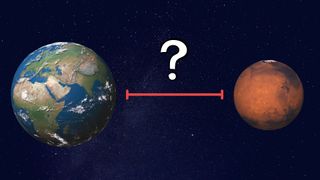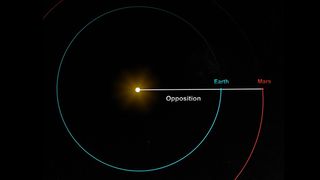Distance to Mars: How far away is the Red Planet?
The distance to Mars from Earth is not that simple.

The distance to Mars from Earth varies considerably depending on their orbits around the sun.
In theory, the closest Mars and Earth would get is when Mars reaches its closest point to the sun (perihelion) and Earth is at its farthest (aphelion). This would bring the two planets within 33.9 million miles (54.6 million kilometers) of each other — but this has not yet happened in recorded history according to NASA.
The closest recorded distance to Mars from Earth was recorded in August 2003 when the two were 34.8 million miles (56 million km) apart. According to NASA, the two will not be that close again until the year 2237.
Related: How long does it take to get to Mars?
Mars and Earth are farthest apart when they are both at aphelion and on opposite sides of the sun. Here, they can be 250 million miles (401 million km) apart according to the New York Times. The average distance between Earth and Mars is 140 million miles (225 million km).
Mars orbit, opposition and viewing opportunities
To understand how the distance between Mars and Earth differs so much, we need to look at their orbits.
Neither Earth or Mars' orbit is perfectly circular, so the distance between the two is constantly changing. Think of the planets as two cars on a racetrack, with Earth on the inside lane moving faster than Mars — completing roughly two laps in the same time it takes Mars to complete one.
Mars opposition occurs when Earth "catches up" to Mars and is positioned between the sun and the Red Planet. During Mars oppositions, from Earth, we can see Mars rise in the east as the sun sets in the west, with the Red Planet being visible in our skies all night long. Such oppositions occur roughly every 26 months. Every 15 to 17 years we witness very close Mars oppositions when Earth passes between Mars and the sun during Mars' perihelion (closest point to the sun).

The Red Planet makes for an interesting observing target in the night sky. It appears very bright and is visible even with the naked eye.
If you're looking for a telescope or binoculars to observe Mars, check our guide for the best binoculars deals and the best telescope deals now. If you need imaging gear, consider our best cameras for astrophotography and the best lenses for astrophotography.
Mars close approach

Mars makes a close approach to Earth roughly every 26 months — the same frequency as opposition occurs, according to NASA. Due to their orbital mechanics, the closest approach can occur a few days before or after opposition depending on whether Mars is moving away from the Earth and sun or towards the Earth and sun respectively, according to Celestron.
Not only does this time make for great skywatching opportunities but is also the best time to launch a spacecraft to the Red Planet. Many missions have taken advantage of the close distance to Mars which is why you'll often see Mars missions launch (if budget allows) every two years.
In 2020, The UAE's Hope mission launched from Japan's Tanegashima Space Center on Jul. 19, China's Tianwen-1 mission launched from Hainan Island's Wenchang Satellite Launch Center on Jul. 23 and NASA's Mars 2020 mission launched from Florida's Space Coast on Jul. 30, carrying the Perseverance rover. According to The Planetary Society, this was the first time three different countries have launched missions during the same window of opportunity.
Distance between Mars and the sun
The average distance between Mars and the sun is 142 million miles (228 million kilometers). According to a NASA fact sheet, due to Mars' eccentric orbit, at its closest (perihelion) Mars is about 128 million miles (206 million km) from the sun and at its farthest distance (aphelion) Mars is about 154 million miles (249 million km) from the sun.

Measuring the distance between Earth and Mars
According to the Teacher's Guide to the Universe from Princeton University, the distance between Earth and Mars was first determined by Giovanni Cassini in 1672 using the parallax method.
Cassini achieved this by sending his fellow astronomer Jean Richer to French Guiana to carry out measurements while he remained in Paris. They took measurements of the position of Mars and triangulated those measurements with the known distance between Paris and French Guiana. Cassini's calculation was only off by 7% compared to today's more accurate measurements.
Nowadays, with several spacecraft orbiting or roaming along the surface of the Red Planet, scientists can use the speed of light to determine how far away Mars is from Earth, by measuring the time it takes for signals to reach Martian spacecraft, according to Universe Today.
Additional resources
To find out how far away Mars is from Earth right now, check out this guide from The Sky Live. For a nice visualization of the distance between Earth and Mars and the time, it would take light to travel between the two, this animation by James O'Donoghue is a good resource. You can learn more about missions to Mars with NASA.
Bibliography
- Conte, Davide, and David B. Spencer. "Mission analysis for Earth to Mars-Phobos distant Retrograde Orbits." Acta Astronautica 151 (2018): 761-771.
- NASA’s Mars 2020 Project, Report No. IG-17-009, Jan. 30, 2017.
- Bell, J. F., et al. "Hubble space telescope imaging and spectroscopy of Mars during the extremely close approach of 2003." AGU Fall Meeting Abstracts. 2003
Join our Space Forums to keep talking space on the latest missions, night sky and more! And if you have a news tip, correction or comment, let us know at: community@space.com.
Get the Space.com Newsletter
Breaking space news, the latest updates on rocket launches, skywatching events and more!

Daisy Dobrijevic joined Space.com in February 2022 having previously worked for our sister publication All About Space magazine as a staff writer. Before joining us, Daisy completed an editorial internship with the BBC Sky at Night Magazine and worked at the National Space Centre in Leicester, U.K., where she enjoyed communicating space science to the public. In 2021, Daisy completed a PhD in plant physiology and also holds a Master's in Environmental Science, she is currently based in Nottingham, U.K. Daisy is passionate about all things space, with a penchant for solar activity and space weather. She has a strong interest in astrotourism and loves nothing more than a good northern lights chase!
